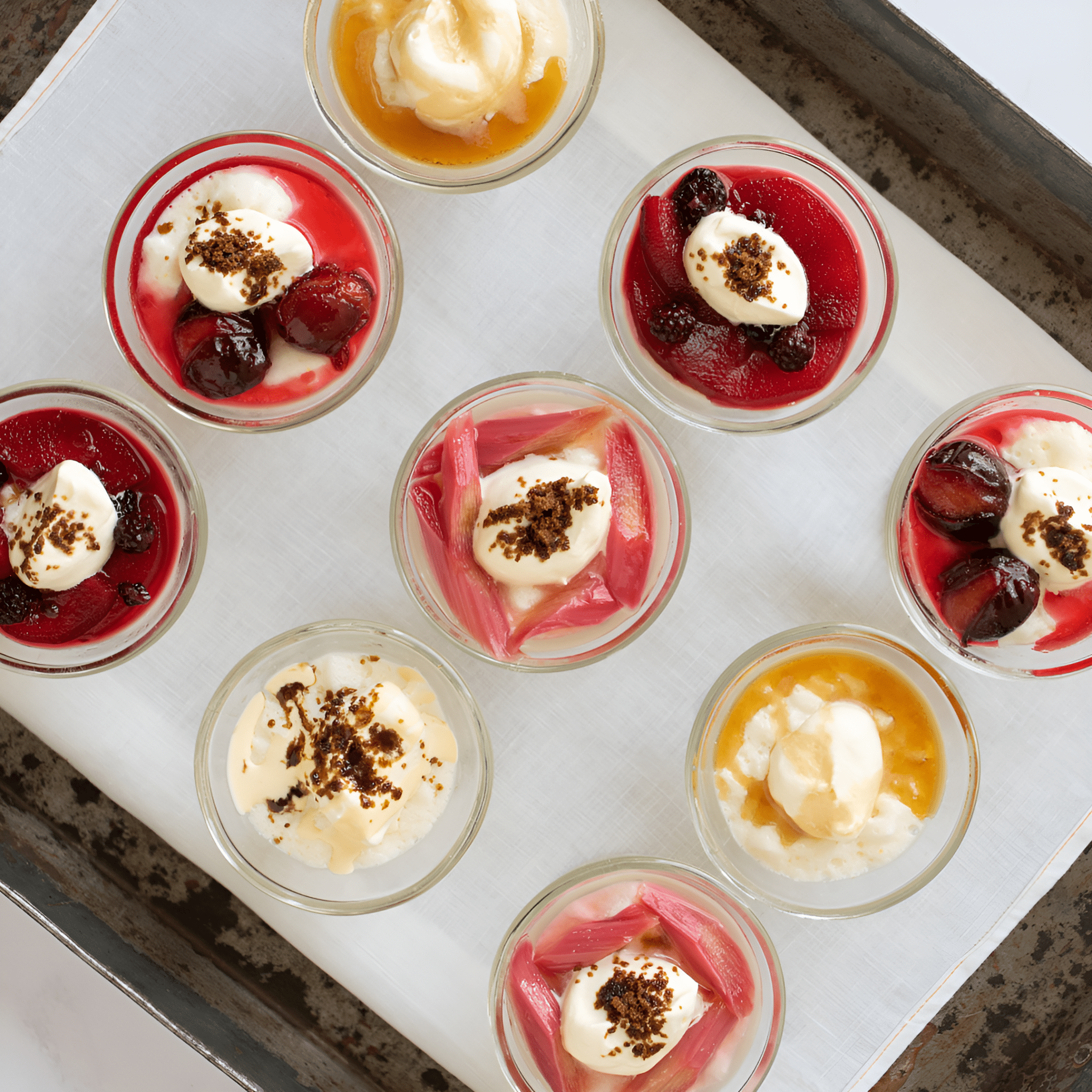Serves 6
- 7 g/¼ oz (approx. 1 semi-closed fistful) cleaned, well-dried carrageen moss
- 900 ml/30 fl oz (3¾ cups) milk
- 1 vanilla pod or 1 teaspoon pure vanilla extract
- 1 large egg
- 2 tablespoons caster (superfine) sugar
To serve
softly whipped cream
dark muscovado sugar or Irish Coffee Sauce
Have a 1.2 litre/2 pint (5 cup) serving dish or eight individual serving glasses to hand and set to one side.
Soak the carrageen moss in a bowl of tepid water for 10 minutes. It will swell and increase in size. Strain off and discard the water and then put the carrageen into a saucepan with the milk and the vanilla pod, if using. (If using vanilla extract, it will be added later.) Bring the milk slowly to the boil, watching that it doesn’t heat too fast: if the milk heats too quickly, it might suddenly expand in volume and overflow. Reduce the temperature to maintain a very gentle simmer for about 15 minutes, until the carrageen moss has softened and somewhat dissolved into the milk.
Remove the saucepan from the heat. Test for a set by placing a teaspoon of the mixture on a saucer. This small amount, when cooled, will show how firm a set the pudding will have. Ideally the mixture should have a soft set; if it is too firm a little more milk can be added to adjust it. If it does not test for a set, cook for a few more minutes.
At that point and not before, separate the egg. Put the white in a spotlessly clean bowl and set to one side. Put the yolk into a separate bowl with the sugar and vanilla extract, if using, and whisk together for a few seconds. Pour the hot milk and carrageen moss through a fine mesh sieve into the egg yolk mixture, whisking all the time. By now the carrageen in the strainer will be swollen and exuding jelly and you will need to press as much of this as possible through the sieve. Use a rubber spatula, scraping any pulp stuck to the outside of the sieve into the egg and milk mixture and whisk to combine. Discard the vanilla pod, if using.
Whisk the egg white to a stiff peak and gently fold it into the top of the milk mixture, allowing it to remain as slightly uneven fluffy peaks. Do not be tempted to over mix, as the egg white should create a distinct layer on top. Transfer to the serving dish, or divide between the individual serving glasses, and place in the fridge to set for at least 3 hours or overnight.
Serve chilled with softly whipped cream and dark muscovado sugar or Irish coffee sauce.
Notes:
At first glance, people wonder how a dessert so pure and white could be made from seaweed. There is usually curiosity around the heritage of the dish, as Ireland is not the first country that springs to mind when one thinks of consuming seaweed. But the tradition of using carrageen moss to set milk puddings, to thicken throat syrups and to add nutrients to animal feed goes back centuries. The name ‘carrageen’ is from the Irish ‘carraigín’, translating to ‘little rock’ – apt considering this seaweed grows abundantly on little rocks around our coastline. There are two varieties of seaweed with the name carrageen moss (also known as Irish moss), Chondrus crispus and Mastocarpus stellatus; they are similar and can be used interchangeably in cookery. Primarily, carrageen moss is used in the kitchen as a gelling agent – a natural source used to thicken or set liquids. It also has been an important ingredient in traditional Irish home remedies.
Carrageen moss pudding is a Ballymaloe speciality, and we serve it on the dessert trolley every night. Mrs Allen’s recipe yields a silky and delicate dessert, with the most pleasing texture that is transcendent. The trick is to use just enough moss for the milk to have a soft set and gentle flavour – too much and the dish will be firm and less sophisticated and have too strong a ‘seaweed’ flavour. At Ballymaloe we like to serve the pudding with softly whipped cream, a sprinkle of soft dark brown sugar and a fruit compote of what’s in season. For a party, Mrs Allen liked to serve the pudding topped with a thick Irish Coffee Sauce and whipped cream.
whipped cream and coffee sauce strongly laced with whiskey
The job of finding and harvesting enough carrageen moss for Ballymaloe to be self-sufficient requires many hands and careful timing. For decades Mrs Allen managed the annual picking at Ballyandreen, a small rocky inlet four miles south of Ballymaloe. Early each summer Mrs Allen kept watch on the local tide times: her preference was to harvest at low water, just as she had been taught by locals when she moved to the area in the 1940s. After it is picked the seaweed must be sorted, cleaned and dried. First it is washed in fresh cold water and any tangled weeds, foreign objects or creatures are removed. Next the moss is laid out on the cliff tops or a patch of grass in a sunny spot. The seaweed naturally bleaches in the sun and any rain that falls washes it further. It must be turned every few days so the sun bleaches it evenly, until it eventually turns white. The dried moss is then ready to use. It can be stored in a dry place almost indefinitely.
Note: Dried carrageen moss weighs very little and is tricky to measure accurately: use too little and the milk won’t set; use too much and the pudding will be too firm. The natural gelling strength of carrageen moss can vary. For this reason, it is important to test the pudding for a set as described in the method below.
Myrtle’s advice for making Carrageen for a Dinner Party:
Make a Carrageen Moss pudding. Set in a shallow bowl. Make a rather thick Irish Coffee sauce. When cold it should coat the back of the spoon. Lay a 1/4 inch layer of this carefully over the top of the Carrageen and top with a layer of whipped cream.
Carrageen Moss’s health benefits are widely known and Myrtle Allen weaned her children on carrageen moss thickened milk but as she says in her original book, “For more sophisticated meals, I serve it topped with whipped cream and coffee sauce strongly laced with whiskey”

